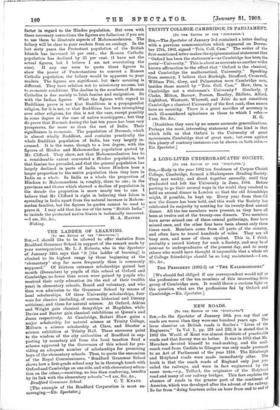[TO TEX EDITOR OP TRH " SPECTATOR:9
Si,—Statistics are proverbially dangerous; and the use Mr. Clifford makes of the Indian Census figures in his letter in the Spectator of January 24th illustrates the danger. For the purposes of his argument the figures he quotes are largely in- correct and fallacious. Buddhists and Mahommedans have not increased to the extent the figures seem to show. Half the increase of the Buddhists, and 15 percent. of the increase of the Mahommedans, are due to the enumeration in 1901 of tracts untouched by the Census of 1891. There is no such disturbing
factor in regard to the Hindoo population. But even with these necessary corrections the figures are fallacious if you are to use them to illustrate aspects of Mahommedanism. The fallacy will be clear to your readers from an analogy. In the last sixty years the Protestant population of the British Islands has increased 50 per cent., the Roman Catholic population has declined by 25 per cent. (I have not the actual figures, but I believe I am not overstating the
case). If any one were to quote these figures to show the power of Protestantism to convert a Roman Catholic population, the fallacy would be apparent to your readers. The figures are significant, but their meaning is different. They have relation not to missionary success, but to economic conditions. The decline in the numbers of Roman Catholics is due mainly to Irish famine and emigration. So with the Indian fignres. What the figures with regard to Buddhism prove is not that Buddhism is a propagandist religion, for it is not, or that Buddhism has been triumphing over other religions, for this is not the case, except possibly in some degree in the case of native worshippers ; but they do prove that Burmah during the last ten years has been very prosperous, far more so than the rest of India. Their significance is economic. The population of Burmah, which is almost wholly Buddhist, and contains practically the whole Buddhist population of India, has very largely in- creased. It is the same, though to a less degree, with the figures of Hindoo and Mahommedan population quoted by Mr. Clifford. They show, not that Mahommedanism has to a. considerable extent converted a Hindoo population, but that famine has prevailed, and that the general population has largely declined in parts of India where Hindoos bore a larger proportion to the entire population than they bore in India as a whole. In India as a whole the proportion of Hindoos to Mahommedans is, roughly, three to one ; in the provinces and States which showed a decline of population in the decade the proportion is more nearly ten to one. I believe that Mr. Clifford is right in believing that Islam is spreading in India apart from the natural increase in Mahom- medan families, but the figures he quotes cannot be used to prove it. I may add that his use of the term "British India" to include the protected native States is technically incorrect.























































 Previous page
Previous page